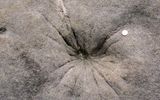
| Added | Sat, 15/08/2020 |
| Sources | |
| Феномены | |
| Version type |
When a very powerful lightning strikes the Earth's surface in the thickness of the soil from the sleeping SiO2 (sand, quartz, silica) formed hollow branch tubes (actually - glass) with a smooth or covered small bubbles inner surface. This is called fulgurite (from Lat. fulgur - lightning strike - Greek εἶδος - similar) or clastofulgurite.
Similarly, the surfaces of any rock (petrofulgurites) are called melted in the same way.
Sometimes individual drops are formed, but more often these are cone-shaped tubes thick with a pencil or with a finger. Their inner surface is smooth and melted, and the outer is formed by pestering to the melted mass of grains of sand and foreign inclusions. This form is connected with the fact that between the grains of sand there is always air and moisture. The electric current of lightning for a fraction of a second heats the air and water vapor to huge temperatures, causing an explosive increase in air pressure between the grains of sand and its expansion. Expanding air forms a cylindrical cavity inside molten sand. The subsequent rapid cooling fixes fulgurite, a glass tube in the sand.
The color of fulgurites depends on the impurities of minerals in the sandy soil. Most of them have a reddish-brown, gray or black color, but there are greenish, white or even translucent fulgurites.
Often neatly dug out of sand fulgurite in shape resembles the root of a tree or branch with numerous growths. Such branched fulgurites are formed when lightning strikes in wet sand, which is known to have more electrical conductivity than dry. In these cases, the current of lightning, entering the soil, immediately begins to spread to the sides, forming a structure similar to the root of the tree, and the fulgurite being born only repeats this form. Fulgurite is very fragile, and attempts to clear the sticky sand often lead to its destruction. This is especially true of branched fulgurites formed in wet sand.
The diameter of the tubular fulgurite is no more than a few centimeters, the length can reach up to several meters, found fulgurite length of 5-6 meters.
The physicist Robert Wood described his experience interestingly:
"There was a severe thunderstorm, and the sky above us has already cleared. I went through the field that separates our house from my sister-in-law's house.
I walked ten yards down the path when my daughter Margaret called me. I stopped for ten seconds and barely moved on, when suddenly the sky cut through a bright blue line, with the roar of a twelve-door gun hitting the path twenty steps in front of me and raising a huge pillar of steam.
I went on to see what trace the lightning had left. In the place where the lightning struck, there was a spot of burnt clover inches in five (12.7 cm) diameter, with a hole in the middle in half an inch.... I went back to the lab, melted eight pounds of tin and poured into the hole...
What I dug up when the tin hardened was like a huge, slightly curved canine arapnik, heavy, as it should be, in the handle and gradually coming down to the end. It was a little longer than three feet."
(cited by W. Seabrook. Robert Wood. - M.: Science, 1985, p. 285).
Related news
Log in or register to post comments











